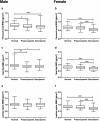Bone mineral density and trabecular bone score in Chinese subjects with sarcopenia
- PMID: 31317519
- PMCID: PMC6825032
- DOI: 10.1007/s40520-019-01266-8
Bone mineral density and trabecular bone score in Chinese subjects with sarcopenia
Abstract
Background: As the general population is aging worldwide, the incidence of sarcopenia and osteoporosis is also rapidly increasing. Studies have found the link between sarcopenia and osteoporosis, but the relationship between sarcopenia and osteoporosis, especially bone microarchitecture, remains unclear.
Aims: To investigate the relationship between components of sarcopenia (muscle mass, handgrip strength, and gait speed) and components of osteoporosis [bone mass measured by bone mineral density (BMD) and bone microarchitecture measured by trabecular bone score (TBS)] in Chinese subjects.
Methods: 318 Chinese men and 203 Chinese women were included in our study. Muscle mass and BMD were measured by dual-energy X-ray absorptiometry (DXA). TBS iNsight® software was used for TBS. Jamar hydraulic hand dynamometer was used to assess muscle strength, and gait speed was used to assess physical performance.
Results: We found that the relative appendicular skeletal muscle mass (RASM) in both genders and handgrip strength in women correlated positively with TBS, RASM in men and handgrip strength in women correlated positively with BMDs. In the multiple linear regression model, RASM was positively associated with TBS in both genders, but no significant association was observed between RASM and BMDs. Interestingly, handgrip strength showed positive association with all evaluated BMDs and TBS in women, but not in men. Women with sarcopenia had lower TBS and BMDs at all evaluated sites. Men with sarcopenia had lower BMDs only at femur neck and total hip.
Conclusions: The reduction of muscle mass and strength was significantly associated with decreased bone mass and deteriorated bone microarchitecture. More importantly, low muscle mass is an independent risk factor for bone microarchitecture in Chinese subjects.
Keywords: Bone mineral density; Osteoporosis; Sarcopenia; Trabecular bone score.
Conflict of interest statement
The authors declare that they have no conflict of interest.
Figures


References
MeSH terms
Grants and funding
LinkOut - more resources
Full Text Sources
Medical
Research Materials

